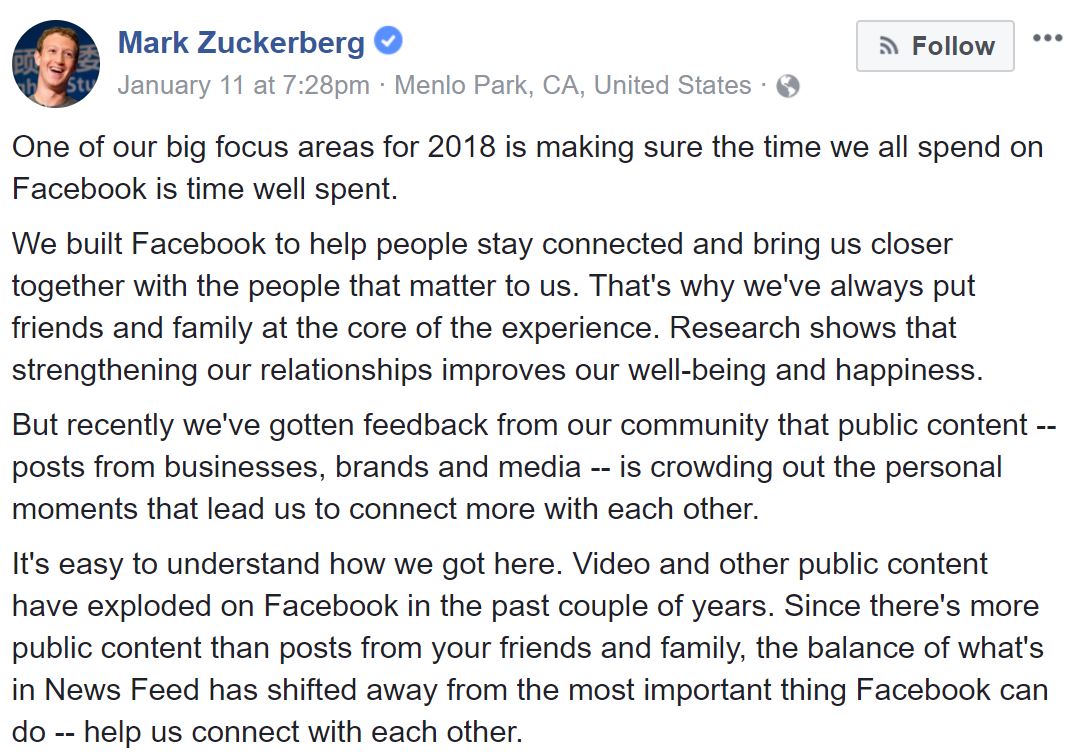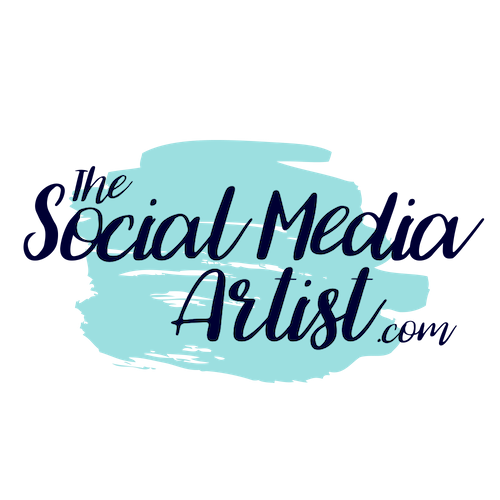The Facebook algorithm changes many times a year, forcing marketers like us to adapt quickly. In the last weeks before 2018, Mark Zuckerberg announced a change to the ad algorithm, that I believe will seriously impact brands and individuals. This post is inspired by the Social Media Marketing Talk Show, where its founder, Michael Stelzner reviews these algorithm changes. I highly recommend listening to it, here (46 min).
This algorithm change will affect almost every business page, brand and personal page. Rather than placing sponsored and sales-driven posts in users’ news feeds, Facebook will prioritize content from friends and family. In the past, the algorithm’s goal was to “show users relevant content”, which helped targeted, sponsored content get seen. Now, there is a shift towards “showing content that sparks conversations and meaningful interaction between people”. This is a radical change, favouring longer comments on posts, over clicks and likes. The idea is to convert users from passively viewing content, to actively engaging with it.
Don’t believe me? See it from Mark himself here.

Why is this happening? For the most part, I believe Facebook is using this strategy to reduce fake news and mismatched content. With this change, Facebook will increase their advertising prices, making it harder for illegitimate publishers to reach their viewers – unless they pay for it. I expect many of these publishers will drop off and use other less restrictive social media platforms to do this.
When Facebook first started in 2004, it was designed to be a platform to connect with friends and have unexpected conversations (this is prior to the days of Messenger). Over the past few years, you might have noticed a growing sour attitude towards social media; to Facebook in particular. I’ve been following this shift, noting that many users are annoyed with the trend towards clickbait and superficial attention grabs. Multiple studies show that social media can have a negative impact on our wellbeing, encouraging people to isolate themselves as they passively binge content, distancing them from actual heartfelt conversations. Many feel that the platform has become ingenuine, and is used increasingly as a way for brands to sell to them. The meaningful social connection that Facebook was famous for, has slowly disappeared.
How do we as creative marketers combat this big shift? How do we fight this cynicism and still get our brands seen by the right people? Here are some predictions and optimization techniques I hope you find helpful:
Comment Strategy
Facebook is favouring longer comments (a sentence or more) and shares to likes and clicks. As marketers we need to be creative, encouraging engaged discussions between users. Posts that encourage generic ’me-too’ comments, like “awesome” or “cool post”, don’t inspire conversation or tell stories, and won’t be prioritized in the news feed. The algorithm will also flag copy that specifically encourages users to comment and like their posts, otherwise known as ‘comment-bait’. No more ‘Tag a friend if you agree’ or ‘Comment below…’ in the copy anymore.
Shift your social media goals from driving traffic to community building. Focus on content that encourages storytelling. Once you build your community, only then should you go back to your sales-driven goals.
To create more visibility on your posts:
Visibility Tip #1: Get your employees to start commenting on your posts. Ask them to ask questions and create longer posts that drive conversation among each other.
Visibility Tip #2: Create a list of followers or other brands that could add value to the conversation. If there is a post that would make sense for them to see, tag them. Consider tagging them within the comment section, rather than the post itself. You want to use this tactic sparingly and tag 1-3 people at a time. No one likes to be spammed.
[Tweet “Get your employees to start commenting on your posts. Ask them to ask questions and create longer posts that drive conversation among each other.”]
Facebook Groups
To encourage a stronger community, create a Facebook group, rather than a Facebook Page to gather a group of like-minded followers. Learn how to speak directly to those followers and encourage them to engage with each other. The idea is to create value for your members by connecting them to each other. You never know whom you can connect together and what impact that has on them!
Community Optimization Tip #1: Create events within these groups. Followers will be notified once they are invited to an event. Whether it’s online or an in-person meetup, make sure to create value for your members.
Community Optimization Tip #2: Introduce members to each other by tagging them in the comment section of your post. Or you can create a specific post introducing them to each other. Perhaps these members have a complementary skill and can benefit from meeting each other online.
[Tweet “introduce members to each other by tagging them in the comment section of your post.”]
Community Optimization Tip #3: If you have a collection of posts from your community, try to get a sense of what they talk about and how to speak similarly. If you need help doing this, you can run conversations through a readability or text analysis tool (e.g. MS Word, Grammarly) and then test your copy to match. You can even run your writing through specialized tools and services like IBM Bluemix and Crystal Knows to help match tone. (Bluemix rated this post as analytical, and unsurprisingly, a mix of joyful and sad)
Facebook Live
Facebook Live gets 8x more exposure than organic posts. Although Mark Zuckerberg announced a decline in passive video content, Facebook Live will not get the boot because it is interactive. This may change in the future, depending on the long-term appeal, and whether the trend continues to decline.
Video Optimization Tip #1: Create different lengths of Facebook Live videos. Perhaps you have a quick 1-minute tip of the week you would like to share. Mix this in with longer pieces like interviews, product reviews, Q&As, tutorials, etc.
Video Optimization Tip #2: Promote your Facebook Live videos with a mini Facebook Live preview piece. In the past, I used to promote Facebook Live with images leading up to the event. However, to accommodate the new algorithm change, it’s worth promoting your longer form pieces with a promo video. For example, if you do a weekly interview with an industry pro, you can let members know the event time and details, introduce the interviewee and collect questions to tailor the interview in your shorter content piece.
Video Optimization Tip #3: Caption, caption, caption. If you live in Ontario, the Accessibility for Ontarians with Disabilities Act (AODA) requires an accessible web experience by 2025. All companies will be mandated to share information in an accessible way. For video, this means captioning the video after the Facebook Live is recorded. Luckily, Facebook has an easy tool that does most of the work for you when you edit the video. Look for “Captions” under edit video and “Generate Captions” to automatically create captions for you. You may have to quickly review the generated captions to catch the occasional typo.
[Tweet “Promote your Facebook Live videos with a mini Facebook Live preview piece”]
Paid Ads
It’s no surprise that reach has been decreasing for advertisers year after year. Now, brands are forced to master Facebook ads to increase reach and accomplish their sales goals. Expect ad prices to increase to accommodate competing advertisers who rely on Facebook ads to accomplish their sales goals.
Reach Optimization Tip #1: Create a campaign with the ad objective ‘drive engagement’ to serve your ads to users who typically comment on posts.
Reach Optimization Tip #2: Boost your Facebook Live videos to improve reach on an already algorithm-friendly content type.
[Tweet “Boost your Facebook Live videos to improve reach on an already algorithm-friendly content type.”]
See Content First
The only way to ensure your followers are seeing your content organically is to encourage them to change their notification option for your brand, to ‘see first’. This ensures your followers will get notified every time you post something new, in real time. Note that this option is limited to 30 pages per user, so your followers must REALLY like your page to do this for you. Time this request for key touchpoints, such as after a positive direct message, in a successful video post, or when you have a spike in engagement in your community.
Are we all doomed? Not necessarily. Pages that have high engagement already, will not be impacted. Those who get a few likes once in a blue moon and have no advertising strategy… Yep, those are the ones that will get affected.
There’s no going back to a ‘free’ world on Facebook. If you want your content out there, you must pay for it. If that’s not your style, it may be time to try out a new platform, HELLO INSTAGRAM 🙂
What do you think of the new change? Have you noticed any differences? If you’ve given up trying to keep up with your own social media, leave it to a pro like me. More about me and how I can help, here.


